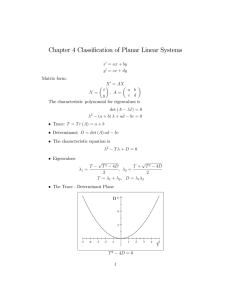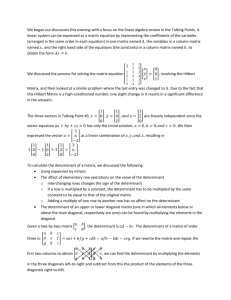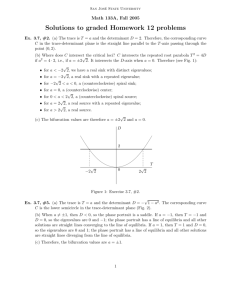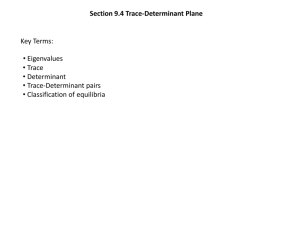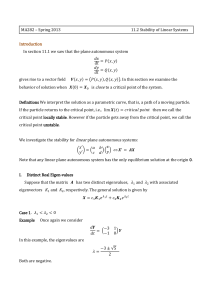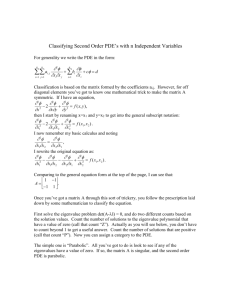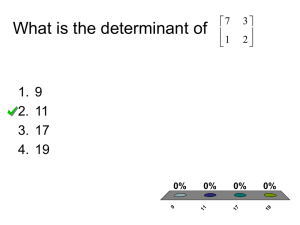Linearization, Trace and Determinant
advertisement
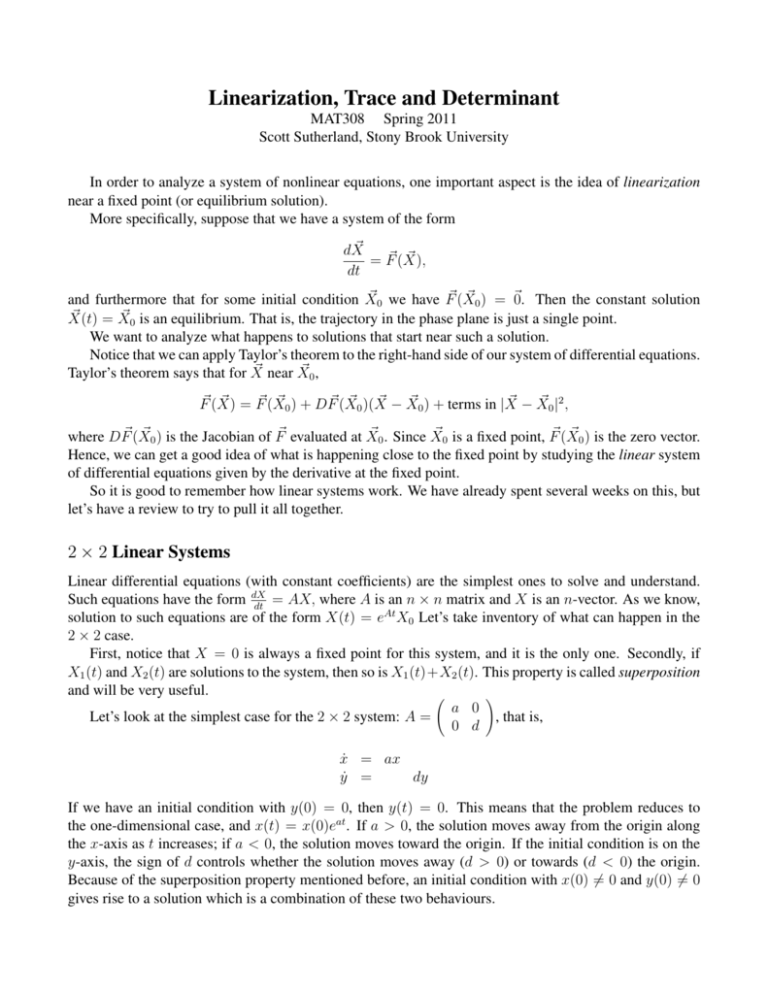
Linearization, Trace and Determinant MAT308 Spring 2011 Scott Sutherland, Stony Brook University In order to analyze a system of nonlinear equations, one important aspect is the idea of linearization near a fixed point (or equilibrium solution). More specifically, suppose that we have a system of the form ~ dX ~ = F~ (X), dt ~ 0 we have F~ (X ~ 0 ) = ~0. Then the constant solution and furthermore that for some initial condition X ~ ~ 0 is an equilibrium. That is, the trajectory in the phase plane is just a single point. X(t) =X We want to analyze what happens to solutions that start near such a solution. Notice that we can apply Taylor’s theorem to the right-hand side of our system of differential equations. ~ near X ~ 0, Taylor’s theorem says that for X ~ = F~ (X ~ 0 ) + DF~ (X ~ 0 )(X ~ −X ~ 0 ) + terms in |X ~ −X ~ 0 |2 , F~ (X) ~ 0 ) is the Jacobian of F~ evaluated at X ~ 0 . Since X ~ 0 is a fixed point, F~ (X ~ 0 ) is the zero vector. where DF~ (X Hence, we can get a good idea of what is happening close to the fixed point by studying the linear system of differential equations given by the derivative at the fixed point. So it is good to remember how linear systems work. We have already spent several weeks on this, but let’s have a review to try to pull it all together. 2 × 2 Linear Systems Linear differential equations (with constant coefficients) are the simplest ones to solve and understand. Such equations have the form dX = AX, where A is an n × n matrix and X is an n-vector. As we know, dt solution to such equations are of the form X(t) = eAt X0 Let’s take inventory of what can happen in the 2 × 2 case. First, notice that X = 0 is always a fixed point for this system, and it is the only one. Secondly, if X1 (t) and X2 (t) are solutions to the system, then so is X1 (t)+X2 (t). This property is called superposition and will be very useful. ! a 0 Let’s look at the simplest case for the 2 × 2 system: A = , that is, 0 d ẋ = ax ẏ = dy If we have an initial condition with y(0) = 0, then y(t) = 0. This means that the problem reduces to the one-dimensional case, and x(t) = x(0)eat . If a > 0, the solution moves away from the origin along the x-axis as t increases; if a < 0, the solution moves toward the origin. If the initial condition is on the y-axis, the sign of d controls whether the solution moves away (d > 0) or towards (d < 0) the origin. Because of the superposition property mentioned before, an initial condition with x(0) 6= 0 and y(0) 6= 0 gives rise to a solution which is a combination of these two behaviours. Linearization, Trace and Determinant a=+4 d=+2 (source) a=–4 2 d=+2 (saddle) a=+4 d=–2 (saddle) a=–4 2 2 2 2 1 1 1 1 y 0 y 0 y 0 y 0 –1 –1 –1 –1 –2 –2 –2 –1 0 x 1 2 –2 –2 –1 0 x 1 2 d=–2 (sink) –2 –2 –1 0 x 1 2 –2 –1 0 x 1 2 A large number of linear systems behave very similarly to the cases above, except the straight-line solutions may not lie exactly along the coordinate axes. Suppose there is a solution of Ẋ = AX which lies along a straight line, that is, along some vector ~v . Because the system is linear, this means the tangent vectors to this solution must be of the form λX for some number λ. Such a number λ is called an eigenvalue, and the corresponding vector ~v is the corresponding eigenvector. Note that in the case above, we had eigenvalues a and d with eigenvectors [1, 0] and [0, 1]. To find the eigenvalues, we need to solve AX = λX, or equivalently, (A − λI)X = 0. This can only happen if X is the zero vector, or the determinant of A − λI is zero. In the latter case, we must have (a − λ)(d − λ) − bc = 0, That is, λ2 − (a + d)λ + (ad − bc) = 0. Using the quadratic formula, we see that the eigenvalues must be λ= (a + d) ± q (a + d)2 − 4(ad − bc) 2 . The quantity a + d is called the trace of A (more generally, the trace of a matrix is the sum of diagonal entries), and ad − bc is the determinant of A. The eigenvalues of a 2 × 2 matrix can be expressed in terms of the trace and the determinant1 as T rA ± q (T rA)2 − 4 detA 2 . We’ll use this form again in a little while. For linear systems, the eigenvalues determine the ultimate fate of solutions to the ODE. From the above, it should be clear that there are always two eigenvalues for a 2 × 2 matrix (although sometimes there might be a double eigenvalue, when (T rA)2 − 4 detA = 0). Let’s call them λ1 and λ2 . We’ve already seen prototypical examples where the eigenvalues are real, nonzero, and distinct. But what if the eigenvalues are complex conjugate (which happens when (T rA)2 < 4 detA)? In this case, there is no straight line solution in the reals. Instead, solutions turn around the origin. If the real part of 1 It is true for all matrices that the trace is the sum of the eigenvalues, and the determinant is their product. Linearization, Trace and Determinant 3 the eigenvalues is positive, solutions spiral away from the origin, and if it is negative, they spiral towards it. If the eigenvalues are purely imaginary, the solutions neither move in nor out; rather, they circle around the origin. We can summarize this in the table below. We are skipping over dealing with the degenerate cases, when λ1 = λ2 and when one of the eigenvalues is zero. λ1 > λ2 > 0 source λi complex, Reλ > 0 spiral source λ1 < λ2 < 0 sink λi complex, Reλ < 0 spiral sink λ1 < 0 < λ2 saddle λi complex, Reλ = 0 center Finally, we remark that there is a convenient way to organize this information into a single diagram. Since the eigenvalues of A can be written as T rA ± q (T rA)2 − 4 detA 2 , we can consider the matrix A as being a point in the Trace-Determinant plane. Then the curve where (T rA)2 = 4 detA is a parabola. If A is above this parabola, itqhas complex eigenvalues. Furthermore, if the determinant is negative, we must have a saddle because2 (T rA)2 − 4 detA > T rA, which means there is one positive and one negative eigenvalue. Finally, if the determinant is positive, the eigenvalues (or their real part, if they are complex) is the same sign as the trace of A. This is summarized this in the diagram below. Det center spiral sink spiral source sink source Tr saddle An animation of this can be found at http://www.math.sunysb.edu/˜scott/mat308. spr11/demovie.html. 2 Since the determinant is the product of the eigenvalues, the only way it can be negative is if they are of opposite signs. Linearization, Trace and Determinant 4 Note that the cases where the detA = 0, T rA = 0, or (T rA)2 = 4 detA are not structurally stable. That is, a tiny change to the entries of A will destroy this property. On the other hand, the other cases are structurally stable: if a system has a sink, any nearby system will also have a sink. We now turn to discussion of the degenerate cases of linear systems. If detA = 0, then there is an eigenvector ~v with a zero eigenvalue. This means that along this vector, solutions are constants. That is, there is an entire line of fixed points along ~v . Solutions nearby this line will move away if the other eigenvalue is positive, or move towards the line if the other eigenvalue is negative. If detA = (T rA)2 /4, either there is only one eigenvector, or all vectors are eigenvectors. The second case is easy: all solution trajectories are rays from or towards the origin. (See picture on right). In the other case, solutions not along the eigenvector curve away (or towards) the eigenvector; they seem to spiral but they cannot complete more than a half-turn. (See picture on left; the eigenvector is along the x-axis). Finally, we’ve already discussed the case were the eigenvalues are purely imaginary (and hence T rA = 0); in this case, the origin is a center. Note that a small change in the entries of A may change the origin from a center to a spiral source or sink.
